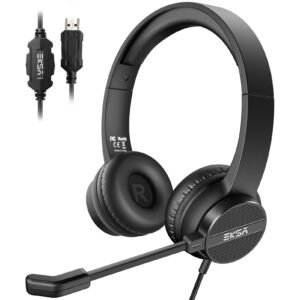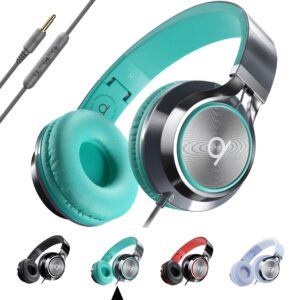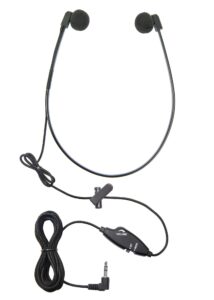We independently select all products and services. If you click through links we provide, Mighty Deals may earn a commission.
Headphones are an essential tool for anyone who does transcription work. Whether we’re transcribing interviews, meetings, or audio notes, clear and comfortable sound is important for accuracy and efficiency. Unlike regular music headphones, the best headphones for transcription help us catch every word and nuance—even when audio recordings are not perfect.
When shopping for headphones for transcription, there are a few things to keep in mind. Audio quality matters most; we need headphones that make voices sound natural and reduce background noise. Comfort is also important for long sessions, as is the build quality, since we may wear them for hours at a time. The length and type of cable, microphone features, and price can also play a role, depending on our work setup.
It’s important to find headphones that balance sound clarity, comfort, and durability for hassle-free transcription work. We spent hours researching and testing top models to recommend the best headphones for transcription.
Best Headphones for Transcription
We’ve selected the top headphones to help make transcription easier and more comfortable. Our choices focus on clear sound and reliable comfort for long work sessions.
1. EKSA USB Headset for PC and Laptop
This headset is a practical choice for anyone transcribing in noisy spaces who values comfort and decent sound clarity.
Pros
- The ear pads feel soft and lightweight, so we could wear them for most of the day without irritation.
- Background noise is noticeably reduced while transcribing, letting us focus on audio details.
- Easy-to-reach volume and mute controls can be adjusted in seconds without breaking concentration.
Cons
- Not adjustable enough for all head sizes—we found that larger heads might not get a proper fit.
- Only works with USB devices, so no direct connection to a phone or tablet.
- Breathing room is limited during hot days since the ear cups don’t ventilate much.
Using the EKSA USB headset, we could hear spoken words clearly, even during busy office hours. The noise-canceling feature made it easier to catch every detail in a recording. Calls and playback remained crisp instead of getting lost in background chatter.
Comfort is reliable for everyday use. With light pressure and soft padding, our ears didn’t ache after a few recording sessions. The in-line controls are intuitive, so we could pause or adjust the volume right away.
If you’re looking for convenience and decent noise reduction in an affordable headset, this one serves its purpose for transcription work. The fixed USB connection might limit where we can use it, but for laptops and desktops, it gets the job done.
2. ARTIX CL750 Wired Headphones
These headphones offer clear audio and a lightweight feel that makes them a practical choice for transcription work on a budget.
Pros
- Comfortable fit for extended sessions
- Clear, balanced sound with decent isolation
- Simple plug-and-play setup
Cons
- Cord feels stiff and may tangle
- On-ear design can cause pressure over time
- Not fully noise cancelling
When we tried the ARTIX CL750 headphones for transcription, we appreciated how light they felt. They did not weigh down our heads even after hours of typing, so it’s easy to forget we’re wearing them. The padded ear cups helped with comfort, though we did notice that the on-ear style doesn’t cover the ears entirely.
Sound quality is one of the highlights here. Speech comes through crisp, making it easier to focus on voices without muddy background noise interfering. The built-in microphone is convenient for calls, and switching between devices was hassle-free thanks to the standard 3.5mm jack.
One area where these headphones fall short is the stiffness of the cord; it seems durable but can be awkward when moving around. While the noise isolation is good for most office and home settings, it lacks the deep seal of higher-end models. For those of us transcribing in busier environments, that’s something to consider. Overall, these are a solid, no-fuss option if you want reliable performance without spending much.
3. BERIBES Bluetooth Headphones
Anyone looking for reliable and comfortable headphones for transcription should consider these for their long battery life and clear sound.
Pros
- Lightweight and comfortable for extended use
- Extremely long battery life
- Adjustable sound modes for different audio needs
Cons
- Not the strongest noise isolation
- Padding shows wear after heavy daily use
- Control buttons can feel a bit stiff
On first use, the BERIBES headphones immediately stand out for their comfort. We found the light weight and soft ear pads made a noticeable difference during long transcription sessions. Even after hours of wear, there was no pressure on our ears or head.
Battery life is where these headphones truly shine. We got through multiple days of steady use on a single charge, which means we could work or transcribe without worrying about running out of power. Switching between Bluetooth and wired connections was seamless and handy when the battery finally ran low.
Sound quality is crisp and customizable thanks to six EQ presets. While we appreciated toggling between balanced sound and extra bass depending on the audio, we noticed the noise isolation wasn’t as strong as with more expensive models. Overall, for those who prioritize comfort, battery life, and versatility, the BERIBES Bluetooth Headphones are a solid choice for transcription work.
4. ECS WordHear-O 3.5mm Transcription Headset
If we’re looking for a lightweight, comfortable headset built for long hours at the desk, this one gets the job done with clear audio and simple design.
Pros
- Comfortable under-chin fit that avoids ear pressure
- Switches effortlessly between mono and stereo
- Long cord makes it easy to move around our workspace
Cons
- Cord durability can be an issue over time
- Occasional sound fading with extended use
- Not ideal for music or high-fidelity playback
The under-chin style of the ECS WordHear-O really sets it apart from the bulkier headsets we’ve tried. We find it stays in place without any ear pain—something that matters a lot during shifts filled with nonstop transcription. Wearing it for hours hasn’t caused us any discomfort, so it suits long workdays.
Switching between mono and stereo with the built-in switch is quick, and the sound comes through very clearly for voices. We don’t have to fuss with adapters and the headset works with all of our main devices. The extra-long cord is convenient—a small touch but one we notice when we need to stretch or shift positions.
On the downside, we’ve had to replace this model after long-term use because the cord eventually gives out. The sound can become inconsistent if the headset has been used daily for months. While it works well for spoken word, it’s not the right fit if we also want to listen to high-quality music.
For daily transcription, we keep coming back to the ECS WordHear-O 3.5mm Transcription Headset for the comfort and reliable performance, knowing that we’ll eventually need to replace it with another of the same.
Buying Guide
When choosing headphones for transcription, we need to focus on comfort first. Since we may wear them for hours, a lightweight design with soft padding prevents discomfort.
Sound clarity is key. Crisp audio lets us catch every word, even with unclear recordings. Headphones that reduce outside noise can help us focus better on the task.
Volume controls and long cables make our work easier. Inline controls let us adjust sound quickly, while a long cable adds flexibility.
Let’s compare some common features:
| Feature | Why It Matters |
|---|---|
| Comfort | Reduces ear strain |
| Noise Isolation | Blocks distracting sounds |
| Volume Control | Easy sound adjustments |
| Lightweight | Good for long sessions |
| Long Cable | More movement flexibility |
We should also look for a snug fit. Loose headphones may slip off, and very tight ones can get uncomfortable over time.
Durability is another factor. Choosing headphones built with sturdy materials means they’ll hold up well with everyday use.
We want simple designs with minimal extras. Too many features can complicate things, so it helps to stick to what we really need for transcription work.
Frequently Asked Questions
Finding the right headphones can help us catch every detail and minimize distractions during transcription. We focus on clarity, comfort, and practical features that make long work sessions more manageable.
What features should I look for in headphones to ensure they are suitable for transcription work?
We recommend headphones with a closed-back design to help block out background sounds. Comfortable ear padding is important for wearing them for hours.
A clear, balanced sound profile helps us hear voices and accents accurately. A long cable or wireless options give us freedom to move around.
How does the sound quality of the Sony MDR-7506 compare to other models for precise transcription?
The Sony MDR-7506 provides very clear and detailed sound. Its emphasis on mids and highs allows us to catch subtle speech patterns.
When compared to other models, we find its clarity and comfort useful for long transcription tasks.
Are there any significant benefits to using wireless headphones for transcription?
Wireless headphones remove the hassle of tangled cords. This makes them easy to use in different setups or when we need to move away from our devices.
However, some wireless headphones can have noticeable latency or need frequent charging, which can interrupt our workflow.
Can the Audio-Technica ATH-M50x headphones deliver clear audio for accurate transcription?
Yes, the Audio-Technica ATH-M50x is known for a balanced and detailed sound. This helps us hear words clearly at different volumes.
The comfortable fit and sturdy build also support long working periods without discomfort.
What makes the Sony WH-1000XM4 headphones a good choice for professional transcriptionists?
The Sony WH-1000XM4 offers strong noise cancellation, which helps us focus in busy environments. The sound profile is tailored for voice, which can help catch spoken words.
We also benefit from long battery life and plush ear cushions.
How important is noise cancellation in headphones used for transcription tasks?
Noise cancellation is helpful when working in loud places. It lets us concentrate on recordings without turning up the volume too high.
We find it especially useful if background noise is a frequent issue during our transcription work.





